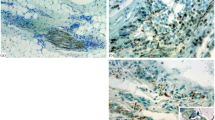Summary
The progress of polyploidization in the human heart muscle cell was investigated by cytofluorometry, involving selective measurements of heart muscle cell nuclei. Thirty-two tissue samples, taken from the free wall of the left ventricle of each autopsied heart, were fixed in Carnoy's fluid. From thick (100–150 μm) paraffin sections, isolated cells for smears were obtained by enzyme digestion and ultrasonic treatment. The smears were stained with azocarmin G to eliminate background fluorescence and subsequently stained by an acriflavine-Feulgen reaction. Cytofluorometric DNA-determinations were carried out selectively on heart muscle cell nuclei, using the muscle striations revealed by azocarmin G-fluorescence as specific markers. The dynamic process of polyploidization in normal hearts could be divided into four stages. In the first stage (under 1 year of age), almost all heart muscle cell nuclei (94.3±1.8%) were diploid. In the second stage (1 to 9 years of age), the number of tetraploid nuclei increased (13.6±7.1%). In the third stage (9 to 22 years of age), octaploid nuclei first appeared and the number of tetraploid nuclei increased (26.7±3.9%). The DNA pattern in the fourth stage (22 to 75 years of age) was relatively constant, with a ratio of diploid (62.4±8.7%), tetraploid (31.4±6.7%) and octaploid (5.8±3.9%) nuclei. From these results it was concluded that physiological polyploidization progresses in proportion to the increase of heart weight. The frequency of polyploid nuclei in human heart was not so high as resported by previous investigators.
Similar content being viewed by others
References
Adler CP (1976) DNS in Kinderherzen, biochemische und zytophotometrische Untersuchungen. Beitr Pathol 158:173–202
Adler CP, Costabel U (1975) Cell number in human heart in atrophy, hypertrophy, and under the influence of cytostatics. In: Fleckenstein A, Rona G (eds) Recent advances in studied on cardiac structure and metabolism. Vol 6: Pathophysiology and morphology of myocardial cell alteration. University Park Press, Baltimore, pp 343–355
Bishop SP (1971) Myocardial cell growth in the normal and hypertrophying neonatal heart (abstr.) Circulation 44:suppl. 2, 142
Böhm N (1972) Fluorescence cytophotometric determination of DNA. In: Glick D, Rosenbaum RM (eds) Techniques of biochemical and biophysical morphology, vol 1. Wiley, New York London, pp 90–141
Buccino RA, Harris E, Span JF, Sonnenbeck EH (1969) Response of myocardial connective tissue to development of experimental hypertrophy. Am J Physiol 216:425–428
Duijndam WAL, Smeulders AWM, van Duijn P, Verweij AC (1980) Optical errors in scanning stage absorbance cytophotometry. J Histochem Cytochem 28:388–394
Eisenstein R, Wied GL (1970) Myocardial DNA and protein in maturing and hypertrophied human hearts. Proc Soc Exp Biol Med 133:176–179
Fujita S, Yoshida S, Fukuda M (1971) Improvement of technique to minimize non-specific absorption in microspectrophotometric measurement of nuclear DNA. Acta Histochem Cytochem 4:126–136
Fujita S, Fukuda M, Kitamura T, Yoshida S (1972) Two-Wavelength-Scanning method in Feulgen cytophotometry. Acta Histochem Cytochem 5:146–152
Fukuda M, Böhm N, Fujita S (1978) Cytofluorometry and its biological application. In: Progress in histochemistry and cytochemistry. vol 11, No 2. Gustav Fischer, Stuttgart New York
Kirk ES, Honig CR (1964) Nonuniform distribution of blood flow and gradients of oxygen tension within the heart. Am J Physiol 207:661–668
Kompmann M, Paddags I, Sandritter W (1966) Feulgen cytophotometric DNA determination on human hearts. Arch Pathol 82:303–308
Lison L (1953) Histochimie et Cytochimie animales. Principles et Methodes. 2e edition. Gauthier-Villars, Paris
Miksche JP, Dhillon SS, Berlyn GP, Landauer KJ (1979) Nonspecific light loss and intrinsic DNA variation problems associated with Feulgen DNA cytophotometry. J Histochem Cytochem 27:1377–1379
Morishita T, Sasaki R, Yamagata S (1970) Studies on deoxyribonucleic acid content and cell count of human heart muscle. Jpn Heart J 11:36–44
Morkin E, Ashford TP (1968) Myocardial DNA synthesis in experimental cardiac hypertrophy. Am J Physiol 215:1409–1413
Neffgen JF, Korecky B (1972) Cellular hyperplasia and hypertrophy in cardiomegalies induced by anemia in young and adult rats. Circ Res 30:104–113
Pearse AGE (1968) Histochemistry: theoretical and applied. 3rd edition. Churchill Livingstone, London New York
Pfitzer P (1971) Nuclear DNA content of human myocardial cells. Curr Topics Pathol 54:125–168
Sandritter W, Scomazzoni G (1964) Deoxyribonucleic acid content (Feulgen photometry) and dry weight (interference microscopy) of normal and hypertrophied heart muscle fibers. Nature 202:100–101
Sandritter W, Adler CP (1978) Polyploidization of heart muscle nuclei as a prerequisite for heart growth and numerical hyperplasia in heart hypertrophy. In: Kobayashi T, Ito Y, Rona G (eds). Recent advances in studies on cardiac structure and metabolism. vol 12: Cardiac adaptation. University Park Press, Baltimore, pp 115–127
Takamatsu T, Nakanishi K, Onouchi Z, Fukuda M, Fujita S (1980) Nonspecific (“pseudoplasma”) dye-binding in the Feulgen nuclear stain and its blocking by azocarmin G. Histochemistry 66:169–180
Takamatsu T, Nakanishi K, Fukuda M, Fujita S (1981) Cytofluorometry on cells isolated from paraffin sections after blocking of the background fluorescence by azocarmin G. Histochemistry 71:161–170
Zak R (1973) Cell proliferation during cardiac growth. Am J Cardiol 31:211–219
Author information
Authors and Affiliations
Rights and permissions
About this article
Cite this article
Takamatsu, T., Nakanishi, K., Fukuda, M. et al. Cytoflurometric nuclear DNA-determinations in infant, adolescent, adult and aging human hearts. Histochemistry 77, 485–494 (1983). https://doi.org/10.1007/BF00495803
Received:
Accepted:
Issue Date:
DOI: https://doi.org/10.1007/BF00495803



